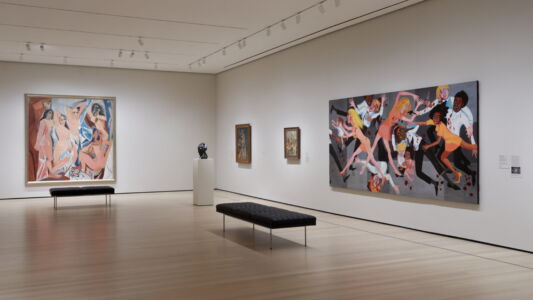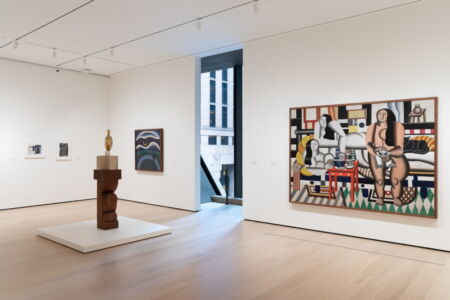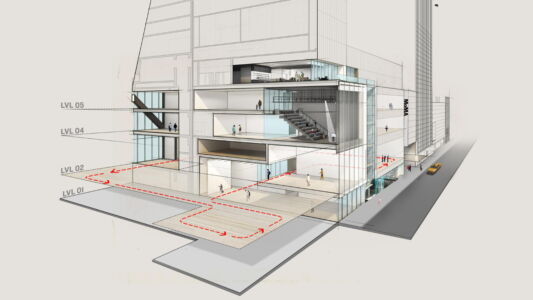The Museum of Modern Art in New York, the holy grail of American modern art, has grown periodically since its original establishment on 53rd Street in 1939. Growth spurts have extended the building westward along the street. Its most recent transformation, by the architects Diller, Scofidio and Renfro, opened in October 2019, a mere 15 years after its penultimate expansion by Yoshio Taniguchi in 2004 (reviewed in this journal).
This new rebuilding follows a three-decade-long burst of collection development and the construction of new museums which have placed the traditional museum at a turning point. The museum’s earlier mandate of collection preservation, research, and display has now been shown to be ineffective in drawing in and satisfying new audiences.
The transformation and expansion is intended to respond to criticism of the museum’s exclusivity in its presentation of modern and contemporary art, and implicitly in its audience response. The restructuring expands MoMA’s gallery space by 30%, and allows for the thorough reconsideration of the entire collection. The reopening has been extensively reviewed in the press, and the critics have particularly considered two aspects – the meaning of the new modes and content of the displays, and to a lesser extent the architecture of the expanded building.
The latter can be summarized as an effort at architectural subversion and ‘opportunistic design,” the self-declared strategy of the Diller, Scofidio and Renfro team of architects.
Eroding the clarity that Taniguchi had imbued into the building—he had wrestled it into a cohesive form even though the site itself is too tenuous to sustain his axes and order—the new design offers several additional extensions that together do not result in an overall architectural statement.
Taniguchi had introduced several notable and noble spaces, such as the great lobby that tunneled through the building and tied it into the grid of the city, the framing of the sculpture garden with pavilion-like wings, and the great vertical space that shot through the museum – providing it with a core that the visitor then circumambulated to see the permanent and the temporary exhibitions.
Taniguchi had presented a “main river with eddies” along axes and a court, encouraging loops of movement in the visitor. All of this is now subverted by counter-tunneling, with new galleries added to the west of the building that now occupies much of the north side of 53rd Street, without any gain in architectural cohesion.
The western development burrows across the site of the demolished Museum of American Folk Art (by Todd Williams and Billie Tsien) and the lower floors of a new, cartoonish skyscraper, with its oversized drama of heavy diagonal bracing, by Jean Nouvel. Galleries spill into one another, without any respite for the visitor, already unmoored by the curatorial decision to dismiss the MoMA’s famed linear narrative of Modernism, in favor of “openness, tolerance, and inclusivity,” as declared in the new mission statement.
Furthermore, the curators have promised the overhaul of one-third of the galleries on a half-yearly cycle. Stephen Rustow, professor of architecture at the Cooper Union and architect in charge of construction during the previous transformation, suggests that “this abandonment of the artistic linear narrative is matched perfectly in the abandonment of spatial hierarchy, or any organizing principle,” in the making of the expansion.
The ground floor has been transformed through the lowering of the museum shop below street level – into which one nearly falls, so very close it is to the main entry. Underlining the now preferred entry directly into the new galleries, the visitor is wrenched towards the various services that have been moved to the passage towards the west; once there, elegant staircases punctuate the visitor’s trajectory, marking off the new from the old. The importance of the great axis of the through lobby (linking 53rd and 54th Streets), countered by the verticality of the core gallery, has been diminished in favor of a maze of remarkably pleasant galleries, well-lit and detailed in fine materials.
These galleries resemble a meandering stream where one hardly understands one’s location and direction, but where the new displays ensure amusement and amazement. The broad use of luxurious materials, whimsically applied, like the dazzling black and white marble walls in one of the many lounging areas, is accompanied by a steady flow of seating furniture, cafés and restaurants interspersed among the largely-identical, well-lit galleries, affording visitors an experience remarkably analogous to surfing the web.
One rues the MoMA’s leadership inability to move its operations to a more suitable site, as the Whitney Museum’s leadership has managed to do recently. Urbanistically, a freestanding building is supremely difficult to achieve on Manhattan’s street grid, especially on a site located on a narrow side street rather than an avenue. The relic-like value of the 53rd Street address makes translocation evidently unthinkable, but given the tremendous expenditure in grafting the new galleries onto other buildings with little visual gain for the museum—it has no proper façade—one wonders how many more times the growth of the museum could be accommodated without a drastic change of location.






























